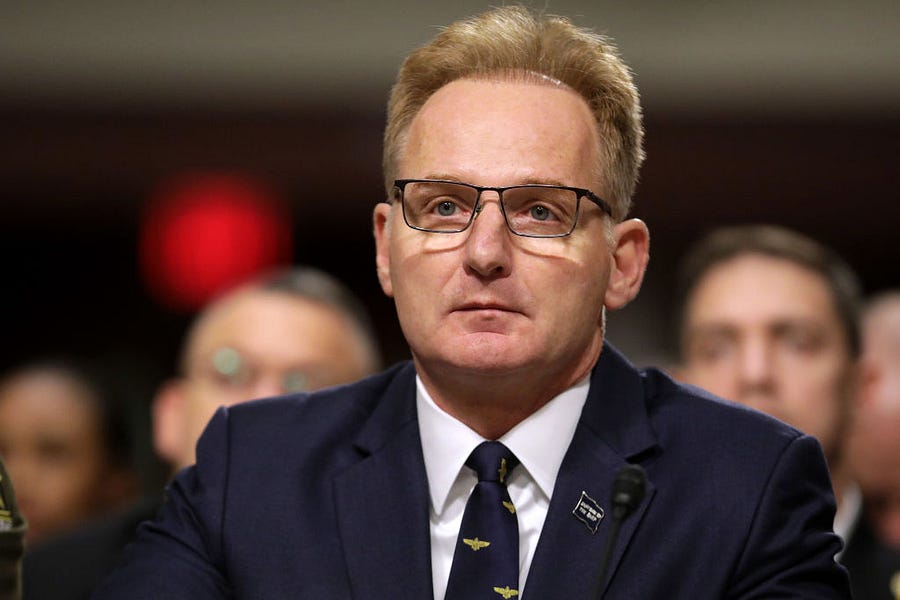Around Thanksgiving of last year, Thomas Modly accepted the role as acting secretary of the Navy in the wake of controversy. His predecessor, Richard Spencer, had been fired by Defense Secretary Mike Esper for trying to negotiate a satisfactory end to the war crimes scandal involving Chief Eddie Gallagher by working directly with the White House staff—without Esper’s knowledge. Modly was determined not to suffer a similar fate. His would be a tenure free from drama.
Modly was exceptionally qualified for the job. He had degrees from both the Naval Academy and Harvard. He’d served in the Navy for seven years as a helicopter pilot. He worked in both the private sector and government. He knew firsthand how the fleet operated, what motivated industry, and how defense budgets were assembled and pushed through Congress.
He set the tone without delay. His priority would be to give President Trump something the previous secretary had failed to deliver: an actionable plan to build 355 ships for the U.S. Navy—a campaign promise that was going the way of the border wall and health care Americans would like better than Obamacare. Through the 2019 holiday season, as the White House was consumed with the presidential impeachment process, Modly worked tirelessly with requirements officers, program managers, budgeteers, shipbuilding CEOs, and professional staffers on the Hill to forge a plan.
Then the coronavirus pandemic hit America or—more specifically to Modly’s purview—the Navy. In early March, the aircraft carrier Theodore Roosevelt pulled into Da Nang, Vietnam, for a port call. The carrier had no sooner returned to sea when two crew members tested positive for COVID-19. It was Capt. Brett Crozier’s worst nightmare. Although the two sailors were immediately flown to the nearest shore station, the commanding officer was confident that more among the 4,500 crew members had the virus. He immediately instituted the basic coronavirus countermeasures, but things like social distancing are problematic when living and working in cramped quarters aboard ship. More sailors reported to the Roosevelt’s medical spaces with symptoms of the virus. Soon there were dozens, then more than 100.
What happened next is unclear. (The vice chief of naval operations is heading an investigation to determine the exact series of events, the results of which were originally due yesterday.) But what is very clear is the crisis resulted in a very public—the most public—showdown between Capt. Crozier and Acting Secretary Modly.
From Crozier’s viewpoint, he was dealt a bad hand and each subsequent card he swapped out made it worse. He lacked COVID-19 test kits and once he got the carrier to Guam as the fleet commander directed, there was no plan on how to accommodate the crew. As far as he was concerned, his pleas up the chain of command were not resulting in swift and decisive action. He was in extremis; it was time for extreme measures to safeguard the health and well-being of his crew. And though he didn’t make it public at the time, his concerns were further intensified by the fact he’d tested positive for coronavirus.
Crozier emailed a copy of his official letter—a full-throated plea for assistance that framed the consequences for inaction in dire terms—to at least 20 recipients outside of official channels. The email quickly found its way into the hands of a reporter at the San Francisco Chronicle and was published shortly thereafter to wide national interest. (Ironically, the aircraft carrier’s namesake had used a similar tactic in 1898 when dealing with an outbreak of yellow fever among his troops in Cuba. In his case, then-Col. Roosevelt slipped a copy of his official petition to get his soldiers back to the U.S. to the Associated Press reporter covering the Cuba beat.)
That Crozier’s letter became the topic of breaking news nationwide surprised Secretary Modly, to put it mildly. For his part, the last he knew, following direct communications with Crozier the day before the letter was published, was that the captain was happy with his level of support and required no pressure to be applied from the top. Now, Modly was being made to appear across the globe as unresponsive to the situation and uncaring about the health of the crew. He was sure that wasn’t going to please his boss, Defense Secretary Esper, not to mention the commander in chief, so he decided to take swift and unflinching action.
Modly felt betrayed by Crozier, and he immediately removed him from command of the Roosevelt, citing “loss of confidence in his ability to command” based on “poor judgment” in allowing his letter to reach the outside world. The public outcry against the firing was widespread; the punditry framed the move as yet another example of the military hazarding the troops in the face of political concerns. Whatever the actual facts, the media fashioned Crozier into a brave leader punished for trying to do the right thing. His folk hero status was cemented by a viral video that showed a large percentage of the crew cheering his name as he walked off of the carrier for the final time.
The optics weren’t good for Modly, and they got worse as Crozier’s coronavirus diagnosis was made public. The acting secretary—heretofore known as a thoughtful and highly reasonable man—was taking shots from places he never had before, including personal threats to him and his family. But he was bullish on the empirical rightness of his actions and confident that he had the support of the president, evinced by Trump’s statement at the most recent coronavirus task force daily press briefing that Crozier’s release of the letter was “terrible” and not “appropriate.” Trump added: “This isn’t a class on literature. This is a captain of a massive ship that’s nuclear-powered.”
In spite of—or maybe because of—the apparent support of the president, the public pressure on Modly to reverse his decision grew. So, he decided to take his case directly to the crew of the Roosevelt docked in Guam, some 8,000 miles away. The plan backfired.
Whether it was the culmination of days of unrelenting stress or jet lag or whatever, Modly’s remarks from the bridge to the entire crew over the ship’s intercom system came off as strongly critical of their beloved former captain. During his rambling 15-minute diatribe he argued—based on Crozier’s release of the letter outside of official channels—the captain was “either too naïve or too stupid to be a commanding officer of a ship like this.” He also said that if the captain did what he did on purpose, he’d committed “a serious violation” of the Uniform Code of Military Justice.
As Modly left the ship to fly back home, the carrier’s leaders, including the air wing commander, were concerned enough that they directed the sailors to destroy any voice files that had been created during his remarks. Surprisingly enough, a transcript of his speech and later the actual voice file made their way to several military media outlets. Whatever bonhomie Modly had retained from hardliners at that point was destroyed as the speech reached every corner of every medium in short order.
But he still had the support of the defense secretary and POTUS, or so he believed. During the flight back to D.C., when made aware of the fact the speech had gone viral, he released an official statement doubling down on the sentiments he’d put out aboard the carrier, indicating his message was intended for the crew only and not the public. The irony of that statement in light of his justification for Crozier’s dismissal was most likely lost on him in the moment.
Then, a few hours later, the most amazing thing happened, something arguably only possible at the hands of President Donald J. Trump. During the daily coronavirus task force press conference at the White House, a reporter asked the president if he’d seen or heard Modly’s remarks given on the aircraft carrier earlier that day. Trump allowed that he had, and he described the speech as “a rough statement.”
With the wonder of someone just learning about the wickets required to fly helicopters and get selected to command a nuclear aircraft carrier, he went on to say that he’d reviewed Crozier’s record and, in a complete turnabout of his attitude toward the captain from the previous press conference, told the assembled reporters that Crozier was a top officer who “didn’t deserve to have his career destroyed because he had one bad day.”
Trump went on to frame the situation surrounding the Theodore Roosevelt like this: “You have two good people, and they’re arguing.” (Note the parity in his mind between a Navy captain and the acting secretary of the Navy.) “I’m good, believe it or not, at settling arguments. I may look into it in detail, and I will be able to figure it out very fast.”
Whatever happened behind the scenes at the White House and the Pentagon, a few hours later Modly released this statement:
I want to apologize to the Navy for my recent comments to the crew of the TR. Let me be clear, I do not think Captain Brett Crozier is naïve nor stupid. I think, and always believed him to be the opposite. We pick our carrier commanding officers with great care. Captain Crozier is smart and passionate. I believe, precisely because he is not naïve and stupid, that he sent his alarming email with the intention of getting it into the public domain in an effort to draw public attention to the situation on his ship. I apologize for any confusion this choice of words may have caused. I also want to apologize directly to Captain Crozier, his family, and the entire crew of the Theodore Roosevelt for any pain my remarks may have caused. They, and the entire Navy, have my full commitment that I will continue to help get the TR back to full health and back to sea where we can move forward beyond this unfortunate situation.
Modly handed his resignation letter to Defense Secretary Esper on Tuesday afternoon. More remarkable is that it’s within the realm of possibility—based on Trump’s change in tone toward Crozier at the press conference—that the president will weigh in on the captain’s behalf to get him his job as carrier commanding officer back or at least see that his record is cleared so that he might still make admiral in the future.
All of this could happen only in the Trump era. And Cabinet members and other political appointees who really believe they can predict the direction he’ll go at any given time should not only add this episode to the ever-growing list of cautionary tales generated by this presidency. They should look at what Trump said Tuesday when asked about Modly: “I don’t know him.”
Ward Carroll is a retired naval aviator and writer. Follow him on Twitter at @wardcarroll.
Photograph of Thomas Modly by Chip Somodevilla/Getty Images.
Correction, April 9, 2020: The original sub-headline mistakenly said that Capt. Crozier resigned. He was relieved of his command.







Please note that we at The Dispatch hold ourselves, our work, and our commenters to a higher standard than other places on the internet. We welcome comments that foster genuine debate or discussion—including comments critical of us or our work—but responses that include ad hominem attacks on fellow Dispatch members or are intended to stoke fear and anger may be moderated.